1993 Jeep Cherokee
GENERAL INFORMATION
Waveforms - Injector Pattern Tutorial
* PLEASE READ THIS FIRST *
NOTE: This article is intended for general information purposes
only. This information may not apply to all makes and models.
PURPOSE OF THIS ARTICLE
Learning how to interpret injector drive patterns from a Lab Scope can be like learning ignition patterns all over again. This article exists to ease you into becoming a skilled injector pattern interpreter.
You will learn:
How a DVOM and noid light fall short of a lab scope.
The two types of injector driver circuits, voltage controlled
& current controlled.
The two ways injector circuits can be wired, constant
ground/switched power & constant power/switched ground.
The two different pattern types you can use to diagnose with,
voltage & current.
All the valuable details injector patterns can reveal.
SCOPE OF THIS ARTICLE
This is NOT a manufacturer specific article. All different types of systems are covered here, regardless of the specific year/make/model/engine.
The reason for such broad coverage is because there are only a few basic ways to operate a solenoid-type injector. By understanding the fundamental principles, you will understand all the major points of injector patterns you encounter. Of course there are minor differences in each specific system, but that is where a waveform library helps out.
If this is confusing, consider a secondary ignition pattern. Even though there are many different implementations, each still has a primary voltage turn-on, firing line, spark line, etc.
If specific waveforms are available in On Demand for the engine and vehicle you are working on, you will find them in the Engine Performance section under the Engine Performance category.
IS A LAB SCOPE NECESSARY?
INTRODUCTION
You probably have several tools at your disposal to diagnose injector circuits. But you might have questioned "Is a lab scope necessary to do a thorough job, or will a set of noid lights and a multifunction DVOM do just as well?"
In the following text, we are going to look at what noid lights and DVOMs do best, do not do very well, and when they can mislead you. As you might suspect, the lab scope, with its ability to look inside an active circuit, comes to the rescue by answering for the deficiencies of these other tools.
OVERVIEW OF NOID LIGHT
The noid light is an excellent "quick and dirty" tool. It can usually be hooked to a fuel injector harness fast and the flashing light is easy to understand. It is a dependable way to identify a no-pulse situation.
However, a noid light can be very deceptive in two cases:
If the wrong one is used for the circuit being tested.
Beware: Just because a connector on a noid light fits the
harness does not mean it is the right one.
If an injector driver is weak or a minor voltage drop is
present.
Use the Right Noid Light
In the following text we will look at what can happen if the wrong noid light is used, why there are different types of noid lights (besides differences with connectors), how to identify the types of noid lights, and how to know the right type to use.
First, letÆs discuss what can happen if the incorrect type of noid light is used. You might see:
A dimly flashing light when it should be normal.
A normal flashing light when it should be dim.
A noid light will flash dim if used on a lower voltage circuit than it was designed for. A normally operating circuit would appear underpowered, which could be misinterpreted as the cause of a fuel starvation problem.
Here are the two circuit types that could cause this problem:
Circuits with external injector resistors. Used predominately
on some Asian & European systems, they are used to reduce the
available voltage to an injector in order to limit the
current flow. This lower voltage can cause a dim flash on a
noid light designed for full voltage.
Circuits with current controlled injector drivers (e.g. "Peak
and Hold"). Basically, this type of driver allows a quick
burst of voltage/current to flow and then throttles it back
significantly for the remainder of the pulse width duration.
If a noid light was designed for the other type of driver
(voltage controlled, e.g. "Saturated"), it will appear dim
because it is expecting full voltage/current to flow for the entire duration of the pulse width.
LetÆs move to the other situation where a noid light flashes normally when it should be dim. This could occur if a more sensitive noid light is used on a higher voltage/amperage circuit that was weakened enough to cause problems (but not outright broken). A circuit with an actual problem would thus appear normal.
LetÆs look at why. A noid light does not come close to consuming as much amperage as an injector solenoid. If there is a partial driver failure or a minor voltage drop in the injector circuit, there can be adequate amperage to fully operate the noid light BUT NOT ENOUGH TO OPERATE THE INJECTOR.
If this is not clear, picture a battery with a lot of corrosion on the terminals. Say there is enough corrosion that the starter motor will not operate; it only clicks. Now imagine turning on the headlights (with the ignition in the RUN position). You find they light normally and are fully bright. This is the same idea as noid light: There is a problem, but enough amp flow exists to operate the headlights ("noid light"), but not the starter motor ("injector").
How do you identify and avoid all these situations? By using the correct type of noid light. This requires that you understanding
the types of injector circuits that your noid lights are designed for. There are three. They are:
Systems with a voltage controlled injector driver. Another
way to say it: The noid light is designed for a circuit with
a "high" resistance injector (generally 12 ohms or above).
Systems with a current controlled injector driver. Another
way to say it: The noid light is designed for a circuit with
a low resistance injector (generally less than 12 ohms)
without an external injector resistor.
Systems with a voltage controlled injector driver and an
external injector resistor. Another way of saying it: The
noid light is designed for a circuit with a low resistance
injector (generally less than 12 ohms) and an external
injector resistor.
NOTE: Some noid lights can meet both the second and third categories simultaneously.
If you are not sure which type of circuit your noid light is designed for, plug it into a known good car and check out the results. If it flashes normally during cranking, determine the circuit type by finding out injector resistance and if an external injector resistor is used. You now know enough to identify the type of injector circuit. Label the noid light appropriately.
Next time you need to use a noid light for diagnosis, determine what type of injector circuit you are dealing with and select the appropriate noid light.
Of course, if you suspect a no-pulse condition you could plug in any one whose connector fit without fear of misdiagnosis. This is because it is unimportant if the flashing light is dim or bright. It is only important that it flashes.
In any cases of doubt regarding the use of a noid light, a lab scope will overcome all inherent weaknesses.
OVERVIEW OF DVOM
A DVOM is typically used to check injector resistance and available voltage at the injector. Some techs also use it check injector on-time either with a built-in feature or by using the dwell/duty function.
There are situations where the DVOM performs these checks dependably, and other situations where it can deceive you. It is important to be aware of these strengths and weaknesses. We will cover the topics above in the following text.
Checking Injector Resistance
If a short in an injector coil winding is constant, an ohmmeter will accurately identify the lower resistance. The same is true with an open winding. Unfortunately, an intermittent short is an exception. A faulty injector with an intermittent short will show "good" if the ohmmeter cannot force the short to occur during testing.
Alcohol in fuel typically causes an intermittent short, happening only when the injector coil is hot and loaded by a current high enough to jump the air gap between two bare windings or to break down any oxides that may have formed between them.
When you measure resistance with an ohmmeter, you are only applying a small current of a few milliamps. This is nowhere near enough to load the coil sufficiently to detect most problems. As a result, most resistance checks identify intermittently shorted injectors as being normal.
There are two methods to get around this limitation. The first is to purchase an tool that checks injector coil windings under
full load. The Kent-Moore J-39021 is such a tool, though there are others. The Kent-Moore costs around $240 at the time of this writing and works on many different manufacturerÆs systems.
The second method is to use a lab scope. Remember, a lab scope allows you to see the regular operation of a circuit in real time. If an injector is having an short or intermittent short, the lab scope will show it.
Checking Available Voltage At the Injector
Verifying a fuel injector has the proper voltage to operate correctly is good diagnostic technique. Finding an open circuit on the feed circuit like a broken wire or connector is an accurate check with a DVOM. Unfortunately, finding an intermittent or excessive resistance problem with a DVOM is unreliable.
LetÆs explore this drawback. Remember that a voltage drop due to excessive resistance will only occur when a circuit is operating? Since the injector circuit is only operating for a few milliseconds at a time, a DVOM will only see a potential fault for a few milliseconds. The remaining 90+% of the time the unloaded injector circuit will show normal battery voltage.
Since DVOMs update their display roughly two to five times a second, all measurements in between are averaged. Because a potential voltage drop is visible for such a small amount of time, it gets "averaged out", causing you to miss it.
Only a DVOM that has a "min-max" function that checks EVERY MILLISECOND will catch this fault consistently (if used in that mode). The Fluke 87 among others has this capability.
A "min-max" DVOM with a lower frequency of checking (100 millisecond) can miss the fault because it will probably check when the injector is not on. This is especially true with current controlled driver circuits. The Fluke 88, among others fall into this category.
Outside of using a Fluke 87 (or equivalent) in the 1 mS "min-max" mode, the only way to catch a voltage drop fault is with a lab scope. You will be able to see a voltage drop as it happens.
One final note. It is important to be aware that an injector circuit with a solenoid resistor will always show a voltage drop when the circuit is energized. This is somewhat obvious and normal; it is a designed-in voltage drop. What can be unexpected is what we already covered┬ŁŌĆöa voltage drop disappears when the circuit is unloaded. The unloaded injector circuit will show normal battery voltage at the injector. Remember this and do not get confused.
Checking Injector On-Time With Built-In Function Several DVOMs have a feature that allows them to measure injector on-time (mS pulse width). While they are accurate and fast to hookup, they have three limitations you should be aware of:
* They only work on voltage controlled injector drivers (e.g
"Saturated Switch"), NOT on current controlled injector
drivers (e.g. "Peak & Hold").
A few unusual conditions can cause inaccurate readings.
Varying engine speeds can result in inaccurate readings.
Regarding the first limitation, DVOMs need a well-defined injector pulse in order to determine when the injector turns ON and OFF. Voltage controlled drivers provide this because of their simple switch-like operation. They completely close the circuit for the entire duration of the pulse. This is easy for the DVOM to interpret.
The other type of driver, the current controlled type, start off well by completely closing the circuit (until the injector pintle opens), but then they throttle back the voltage/current for the duration of the pulse. The DVOM understands the beginning of the pulse
but it cannot figure out the throttling action. In other words, it cannot distinguish the throttling from an open circuit (de-energized) condition.
Yet current controlled injectors will still yield a
millisecond on-time reading on these DVOMs. You will find it is also always the same, regardless of the operating conditions. This is because it is only measuring the initial completely-closed circuit on-time, which always takes the same amount of time (to lift the injector pintle off its seat). So even though you get a reading, it is useless.
The second limitation is that a few erratic conditions can cause inaccurate readings. This is because of a DVOMÆs slow display rate; roughly two to five times a second. As we covered earlier, measurements in between display updates get averaged. So conditions like skipped injector pulses or intermittent long/short injector pulses tend to get "averaged out", which will cause you to miss important details.
The last limitation is that varying engine speeds can result in inaccurate readings. This is caused by the quickly shifting injector on-time as the engine load varies, or the RPM moves from a state of acceleration to stabilization, or similar situations. It too is caused by the averaging of all measurements in between DVOM display periods. You can avoid this by checking on-time when there are no RPM or load changes.
A lab scope allows you to overcome each one of these limitations.
Checking Injector On-Time With Dwell Or Duty
If no tool is available to directly measure injector
millisecond on-time measurement, some techs use a simple DVOM dwell or
duty cycle functions as a replacement.
While this is an approach of last resort, it does provide
benefits. We will discuss the strengths and weaknesses in a moment,
but first we will look at how a duty cycle meter and dwell meter work.
How A Duty Cycle Meter and Dwell Meter Work
All readings are obtained by comparing how long something has been OFF to how long it has been ON in a fixed time period. A dwell meter and duty cycle meter actually come up with the same answers using different scales. You can convert freely between them. See RELATIONSHIP BETWEEN DWELL & DUTY CYCLE READINGS TABLE .
The DVOM display updates roughly one time a second, although some DVOMs can be a little faster or slower. All measurements during this update period are tallied inside the DVOM as ON time or OFF time, and then the total ratio is displayed as either a percentage (duty cycle) or degrees (dwell meter).
For example, letÆs say a DVOM had an update rate of exactly 1 second (1000 milliseconds). LetÆs also say that it has been measuring/tallying an injector circuit that had been ON a total of 250 mS out of the 1000 mS. That is a ratio of one-quarter, which would be displayed as 25% duty cycle or 15 dwell (six-cylinder scale). Note that most duty cycle meters can reverse the readings by selecting the positive or negative slope to trigger on. If this reading were reversed, a duty cycle meter would display 75%.
Strengths of Dwell/Duty Meter
The obvious strength of a dwell/duty meter is that you can compare injector on-time against a known-good reading. This is the only practical way to use a dwell/duty meter, but requires you to have known-good values to compare against.
Another strength is that you can roughly convert injector mS on-time into dwell reading with some computations.
A final strength is that because the meter averages everything together it does not miss anything (though this is also a
severe weakness that we will look at later). If an injector has a fault where it occasionally skips a pulse, the meter registers it and the reading changes accordingly.
LetÆs go back to figuring out dwell/duty readings by using injector on-time specification. This is not generally practical, but we will cover it for completeness. You NEED to know three things:
Injector mS on-time specification.
Engine RPM when specification is valid.
How many times the injectors fire per crankshaft revolution.
The first two are self-explanatory. The last one may require some research into whether it is a bank-fire type that injects every 360 of crankshaft rotation, a bank-fire that injects every 720, or an SFI that injects every 720 ┬░. Many manufacturers do not release this data so you may have to figure it out yourself with a frequency meter.
Here are the four complete steps to convert millisecond on-time :
Determine the injector pulse width and RPM it was obtained
at. LetÆs say the specification is for one millisecond of on-time at a
hot idle of 600 RPM.
Determine injector firing method for the complete 4 stroke
cycle. LetÆs say this is a 360 bank-fired, meaning an injector fires
each and every crankshaft revolution.
Determine how many times the injector will fire at the
specified engine speed (600 RPM) in a fixed time period. We will use
100 milliseconds because it is easy to use.
Six hundred crankshaft Revolutions Per Minute (RPM) divided by 60 seconds equals 10 revolutions per second.
Multiplying 10 times .100 yields one; the crankshaft turns one time in 100 milliseconds. With exactly one crankshaft rotation in 100 milliseconds, we know that the injector fires exactly one time.
4) Determine the ratio of injector on-time vs. off-time in
the fixed time period, then figure duty cycle and/or dwell. The
injector fires one time for a total of one millisecond in any given
100 millisecond period.
One hundred minus one equals 99. We have a 99% duty cycle. If we wanted to know the dwell (on 6 cylinder scale) , multiple 99% times .6; this equals 59.4 dwell.
Weaknesses of Dwell/Duty Meter
The weaknesses are significant. First, there is no one-to-one correspondence to actual mS on-time. No manufacturer releases dwell/duty data, and it is time-consuming to convert the mS on-time readings. Besides, there can be a large degree of error because the conversion forces you to assume that the injector(s) are always firing at the same rate for the same period of time. This can be a dangerous assumption.
Second, all level of detail is lost in the averaging process. This is the primary weakness. You cannot see the details you need to make a confident diagnosis.
Here is one example. Imagine a vehicle that has a faulty injector driver that occasionally skips an injector pulse. Every skipped pulse means that that cylinder does not fire, thus unburned O2 gets pushed into the exhaust and passes the O2 sensor. The O2 sensor indicates lean, so the computer fattens up the mixture to compensate for the supposed "lean" condition.
A connected dwell/duty meter would see the fattened pulse width but would also see the skipped pulses. It would tally both and likely come back with a reading that indicated the "pulse width" was within specification because the rich mixture and missing pulses offset each other.
This situation is not a far-fetched scenario. Some early GM
3800 engines were suffering from exactly this. The point is that a lack of detail could cause misdiagnosis.
As you might have guessed, a lab scope would not miss this.
RELATIONSHIP BETWEEN DWELL & DUTY CYCLE READINGS TABLE (1)
Dwell Meter (2) Duty Cycle Meter
1 1%
15 25%
30 50%
45 75%
60 100%
(1) - These are just some examples for your understanding.
It is okay to fill in the gaps.
(2) - Dwell meter on the six-cylinder scale.
THE TWO TYPES OF INJECTOR DRIVERS
OVERVIEW
There are two types of transistor driver circuits used to operate electric fuel injectors: voltage controlled and current controlled. The voltage controlled type is sometimes called a "saturated switch" driver, while the current controlled type is sometimes known as a "peak and hold" driver.
The basic difference between the two is the total resistance of the injector circuit. Roughly speaking, if a particular leg in an injector circuit has total resistance of 12 or more ohms, a voltage control driver is used. If less than 12 ohms, a current control driver is used.
It is a question of what is going to do the job of limiting the current flow in the injector circuit; the inherent "high" resistance in the injector circuit, or the transistor driver. Without some form of control, the current flow through the injector would cause the solenoid coil to overheat and result in a damaged injector.
VOLTAGE CONTROLLED CIRCUIT ("SATURATED SWITCH")
The voltage controlled driver inside the computer operates much like a simple switch because it does not need to worry about limiting current flow. Recall, this driver typically requires injector circuits with a total leg resistance of 12 or more ohms.
The driver is either ON, closing/completing the circuit
(eliminating the voltage-drop), or OFF, opening the circuit (causing a total voltage drop).
Some manufacturers call it a "saturated switch" driver. This is because when switched ON, the driver allows the magnetic field in the injector to build to saturation. This is the same "saturation" property that you are familiar with for an ignition coil.
There are two ways "high" resistance can be built into an injector circuit to limit current flow. One method uses an external solenoid resistor and a low resistance injector, while the other uses a high resistance injector without the solenoid resistor. See the left side of Fig. 1.
In terms of injection opening time, the external resistor voltage controlled circuit is somewhat faster than the voltage controlled high resistance injector circuit. The trend, however, seems to be moving toward use of this latter type of circuit due to its lower cost and reliability. The ECU can compensate for slower opening
times by increasing injector pulse width accordingly.
NOTE: Never apply battery voltage directly across a low resistance injector. This will cause injector damage from solenoid coil overheating.
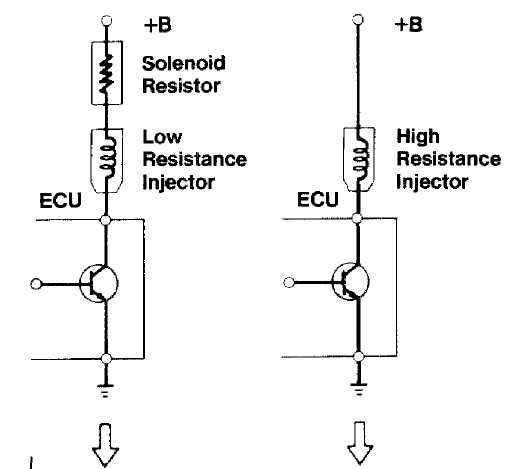

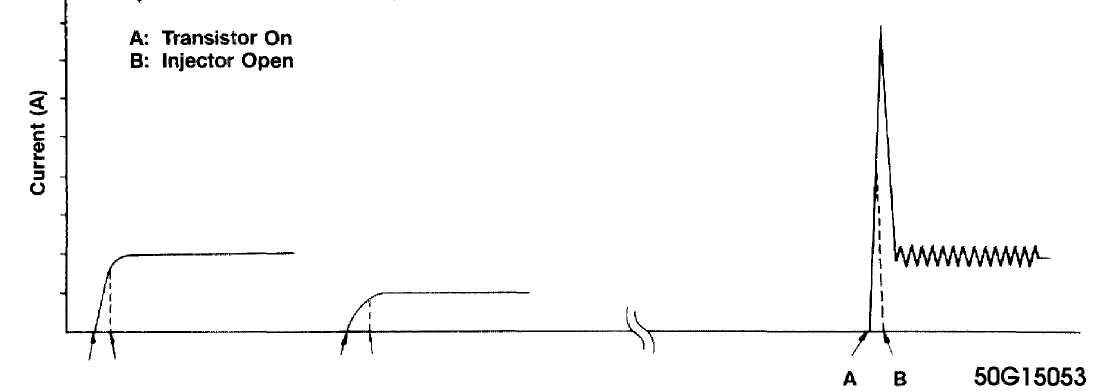
CURRENT-CONTROLLED TYPE
0 +B
VOLTAGE-CONTROLLED TYPE
ąÉ ąÆ ąÉ ąÆ
Fig. 1: Injector Driver Types - Current and Voltage
CURRENT CONTROLLED CIRCUIT ("PEAK & HOLD")
The current controlled driver inside the computer is more complex than a voltage controlled driver because as the name implies, it has to limit current flow in addition to its ON-OFF switching function. Recall, this driver typically requires injector circuits with a total leg resistance of less than 12 ohms.
Once the driver is turned ON, it will not limit current flow until enough time has passed for the injector pintle to open. This period is preset by the particular manufacturer/system based on the amount of current flow needed to open their injector. This is typically between two and six amps. Some manufacturers refer to this
as the "peak" time, referring to the fact that current flow is allowed to "peak" (to open the injector).
Once the injector pintle is open, the amp flow is
considerably reduced for the rest of the pulse duration to protect the injector from overheating. This is okay because very little amperage is needed to hold the injector open, typically in the area of one amp or less. Some manufacturers refer to this as the "hold" time, meaning that just enough current is allowed through the circuit to "hold" the already-open injector open.
There are a couple methods of reducing the current. The most common trims back the available voltage for the circuit, similar to turning down a light at home with a dimmer.
The other method involves repeatedly cycling the circuit ON-OFF. It does this so fast that the magnetic field never collapses and the pintle stays open, but the current is still significantly reduced. See the right side of Fig. 1 for an illustration.
The advantage to the current controlled driver circuit is the short time period from when the driver transistor goes ON to when the injector actually opens. This is a function of the speed with which current flow reaches its peak due to the low circuit resistance. Also, the injector closes faster when the driver turns OFF because of the lower holding current.
NOTE: Never apply battery voltage directly across a low resistance injector. This will cause injector damage from solenoid coil overheating.
THE TWO WAYS INJECTOR CIRCUITS ARE WIRED
Like other circuits, injector circuits can be wired in one of two fundamental directions. The first method is to steadily power the injectors and have the computer driver switch the ground side of the circuit. Conversely, the injectors can be steadily grounded while the driver switches the power side of the circuit.
There is no performance benefit to either method. Voltage controlled and current controlled drivers have been successfully implemented both ways.
However, 95% percent of the systems are wired so the driver controls the ground side of the circuit. Only a handful of systems use the drivers on the power side of the circuit. Some examples of the latter are the 1970Æs Cadillac EFI system, early Jeep 4.0 EFI (Renix system), and Chrysler 1984-87 TBI.
INTERPRETING INJECTOR WAVEFORMS
INTERPRETING A VOLTAGE CONTROLLED PATTERN
NOTE: Voltage controlled drivers are also known as "Saturated
Switch" drivers. They typically require injector circuits with a total leg resistance of 12 ohms or more.
NOTE: This example is based on a constant power/switched ground circuit.
* See Fig. 2 for pattern that the following text describes.
Point "A" is where system voltage is supplied to the
injector. A good hot run voltage is usually 13.5 or more volts. This point, commonly known as open circuit voltage, is critical because the injector will not get sufficient current saturation if there is a voltage shortfall. To obtain a good look at this precise point, you
will need to shift your Lab Scope to five volts per division.
You will find that some systems have slight voltage
fluctuations here. This can occur if the injector feed wire is also used to power up other cycling components, like the ignition coil(s). Slight voltage fluctuations are normal and are no reason for concern. Major voltage fluctuations are a different story, however. Major voltage shifts on the injector feed line will create injector performance problems. Look for excessive resistance problems in the feed circuit if you see big shifts and repair as necessary.
Note that circuits with external injector resistors will not be any different because the resistor does not affect open circuit voltage.
Point "B" is where the driver completes the circuit to ground. This point of the waveform should be a clean square point straight down with no rounded edges. It is during this period that current saturation of the injector windings is taking place and the driver is heavily stressed. Weak drivers will distort this vertical line.
Point "C" represents the voltage drop across the injector windings. Point "C" should come very close to the ground reference point, but not quite touch. This is because the driver has a small amount of inherent resistance. Any significant offset from ground is an indication of a resistance problem on the ground circuit that needs repaired. You might miss this fault if you do not use the negative battery post for your Lab Scope hook-up, so it is HIGHLY recommended that you use the battery as your hook-up.
The points between "B" and "D" represent the time in
milliseconds that the injector is being energized or held open. This line at Point "C" should remain flat. Any distortion or upward bend indicates a ground problem, short problem, or a weak driver. Alert readers will catch that this is exactly opposite of the current controlled type drivers (explained in the next section), because they bend upwards at this point.
How come the difference? Because of the total circuit
resistance. Voltage controlled driver circuits have a high resistance of 12+ ohms that slows the building of the magnetic field in the injector. Hence, no counter voltage is built up and the line remains flat.
On the other hand, the current controlled driver circuit has low resistance which allows for a rapid magnetic field build-up. This causes a slight inductive rise (created by the effects of counter voltage) and hence, the upward bend. You should not see that here with voltage controlled circuits.
Point "D" represents the electrical condition of the injector windings. The height of this voltage spike (inductive kick) is proportional to the number of windings and the current flow through them. The more current flow and greater number of windings, the more potential for a greater inductive kick. The opposite is also true. The less current flow or fewer windings means less inductive kick. Typically you should see a minimum 35 volts at the top of Point "D".
If you do see approximately 35 volts, it is because a zener diode is used with the driver to clamp the voltage. Make sure the beginning top of the spike is squared off, indicating the zener dumped the remainder of the spike. If it is not squared, that indicates the spike is not strong enough to make the zener fully dump, meaning the injector has a weak winding.
If a zener diode is not used in the computer, the spike from a good injector will be 60 or more volts.
Point "E" brings us to a very interesting section. As you can see, the voltage dissipates back to supply value after the peak of the inductive kick. Notice the slight hump? This is actually the mechanical injector pintle closing. Recall that moving an iron core through a magnetic field will create a voltage surge. The pintle is
the iron core here.
This pintle hump at Point "E" should occur near the end of the downward slope, and not afterwards. If it does occur after the slope has ended and the voltage has stabilized, it is because the pintle is slightly sticking because of a faulty injector
If you see more than one hump it is because of a distorted pintle or seat. This faulty condition is known as "pintle float".
It is important to realize that it takes a good digital storage oscilloscope or analog lab scope to see this pintle hump clearly. Unfortunately, it cannot always be seen.
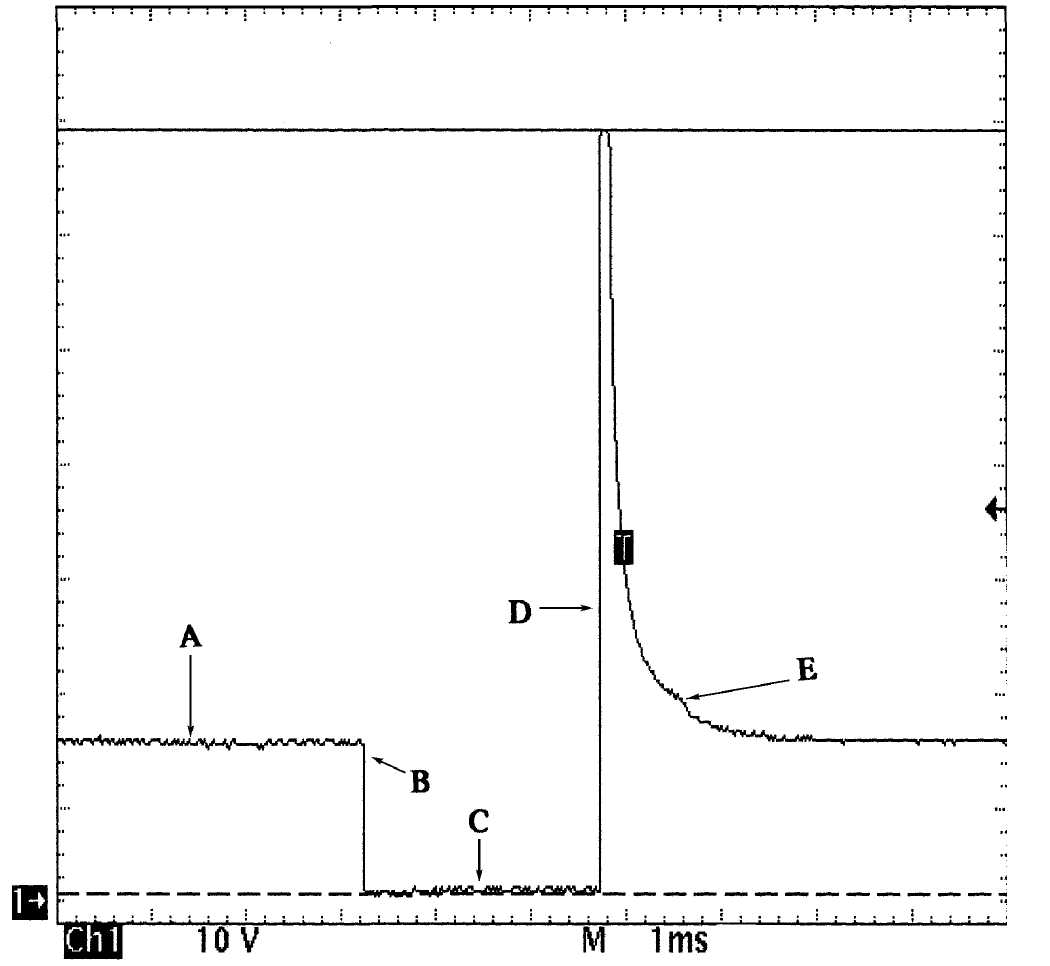
95B23862
Fig. 2: Identifying Voltage Controlled Type Injector Pattern
INTERPRETING A CURRENT CONTROLLED PATTERN
NOTE: Current controlled drivers are also known as "Peak and Hold"
drivers. They typically require injector circuits with a total leg resistance with less than 12 ohm.
NOTE: This example is based on a constant power/switched ground circuit.
* See Fig. 3 for pattern that the following text describes.
Point "A" is where system voltage is supplied to the
injector. A good hot run voltage is usually 13.5 or more volts. This point, commonly known as open circuit voltage, is critical because the injector will not get sufficient current saturation if there is a voltage shortfall. To obtain a good look at this precise point, you will need to shift your Lab Scope to five volts per division.
You will find that some systems have slight voltage
fluctuations here. This could occur if the injector feed wire is also used to power up other cycling components, like the ignition coil(s). Slight voltage fluctuations are normal and are no reason for concern. Major voltage fluctuations are a different story, however. Major voltage shifts on the injector feed line will create injector performance problems. Look for excessive resistance problems in the feed circuit if you see big shifts and repair as necessary.
Point "B" is where the driver completes the circuit to ground. This point of the waveform should be a clean square point straight down with no rounded edges. It is during this period that current saturation of the injector windings is taking place and the driver is heavily stressed. Weak drivers will distort this vertical line.
Point "C" represents the voltage drop across the injector windings. Point "C" should come very close to the ground reference point, but not quite touch. This is because the driver has a small amount of inherent resistance. Any significant offset from ground is an indication of a resistance problem on the ground circuit that needs repaired. You might miss this fault if you do not use the negative battery post for your Lab Scope hook-up, so it is HIGHLY recommended that you use the battery as your hook-up.
Right after Point "C", something interesting happens. Notice the trace starts a normal upward bend. This slight inductive rise is created by the effects of counter voltage and is normal. This is because the low circuit resistance allowed a fast build-up of the magnetic field, which in turn created the counter voltage.
Point "D" is the start of the current limiting, also known as the "Hold" time. Before this point, the driver had allowed the current to free-flow ("Peak") just to get the injector pintle open. By the time point "D" occurs, the injector pintle has already opened and the computer has just significantly throttled the current back. It does this by only allowing a few volts through to maintain the minimum current required to keep the pintle open.
The height of the voltage spike seen at the top of Point "D" represents the electrical condition of the injector windings. The height of this voltage spike (inductive kick) is proportional to the number of windings and the current flow through them. The more current flow and greater number of windings, the more potential for a greater inductive kick. The opposite is also true. The less current flow or fewer windings means less inductive kick. Typically you should see a minimum 35 volts.
If you see approximately 35 volts, it is because a zener diode is used with the driver to clamp the voltage. Make sure the beginning top of the spike is squared off, indicating the zener dumped the remainder of the spike. If it is not squared, that indicates the spike is not strong enough to make the zener fully dump, meaning there is a problem with a weak injector winding.
If a zener diode is not used in the computer, the spike from
a good injector will be 60 or more volts.
At Point "E", notice that the trace is now just a few volts below system voltage and the injector is in the current limiting, or the "Hold" part of the pattern. This line will either remain flat and stable as shown here, or will cycle up and down rapidly. Both are normal methods to limit current flow. Any distortion may indicate shorted windings.
Point "F" is the actual turn-off point of the driver (and injector). To measure the millisecond on-time of the injector, measure between points "C" and "F". Note that we used cursors to do it for us; they are measuring a 2.56 mS on-time.
The top of Point "F" (second inductive kick) is created by the collapsing magnetic field caused by the final turn-off of the driver. This spike should be like the spike on top of point "D".
Point "G" shows a slight hump. This is actually the
mechanical injector pintle closing. Recall that moving an iron core through a magnetic field will create a voltage surge. The pintle is the iron core here.
This pintle hump at Point "E" should occur near the end of the downward slope, and not afterwards. If it does occur after the slope has ended and the voltage has stabilized, it is because the pintle is slightly sticking. Some older Nissan TBI systems suffered from this.
If you see more than one hump it is because of a distorted pintle or seat. This faulty condition is known as "pintle float".
It is important to realize that it takes a good digital storage oscilloscope or analog lab scope to see this pintle hump clearly. Unfortunately, it cannot always be seen.
 M 1ms
M 1ms
Fig. 3: Identifying Current Controlled Type Injector Pattern
CURRENT WAVEFORM SAMPLES
EXAMPLE #1 - VOLTAGE CONTROLLED DRIVER
The waveform pattern shown in Fig. 4 indicate a normal current waveform from a Ford 3.0L V6 VIN [U] engine. This voltage controlled type circuit pulses the injectors in groups of three injectors. Injectors No. 1, 3, and 5 are pulsed together and cylinders 2, 4, and 6 are pulsed together. The specification for an acceptable bank resistance is 4.4 ohms. Using OhmÆs Law and assuming a hot run voltage of 14 volts, we determine that the bank would draw a current of 3.2 amps.
However this is not the case because as the injector windings become saturated, counter voltage is created which impedes the current flow. This, coupled with the inherent resistance of the driverÆs transistor, impedes the current flow even more. So, what is a known good value for a dynamic current draw on a voltage controlled bank of injectors? The waveform pattern shown below indicates a good parallel injector current flow of 2 amps. See Fig. 4.
Note that if just one injector has a resistance problem and partially shorts, the entire parallel bank that it belongs to will draw more current. This can damage the injector driver.
The waveform pattern in Fig. 5 indicates this type of problem with too much current flow. This is on other bank of injectors of the same vehicle; the even side. Notice the Lab Scope is set on a one amp per division scale. As you can see, the current is at an unacceptable 2.5 amps.
It is easy to find out which individual injector is at fault. All you need to do is inductively clamp onto each individual injector and compare them. To obtain a known-good value to compare against, we used the good bank to capture the waveform in Fig. 6. Notice that it limits current flow to 750 milliamps.
The waveform shown in Fig. 7 illustrates the problem injector we found. This waveform indicates an unacceptable current draw of just over one amp as compared to the 750 milliamp draw of the known-good injector. A subsequent check with a DVOM found 8.2 ohms, which is under the 12 ohm specification.
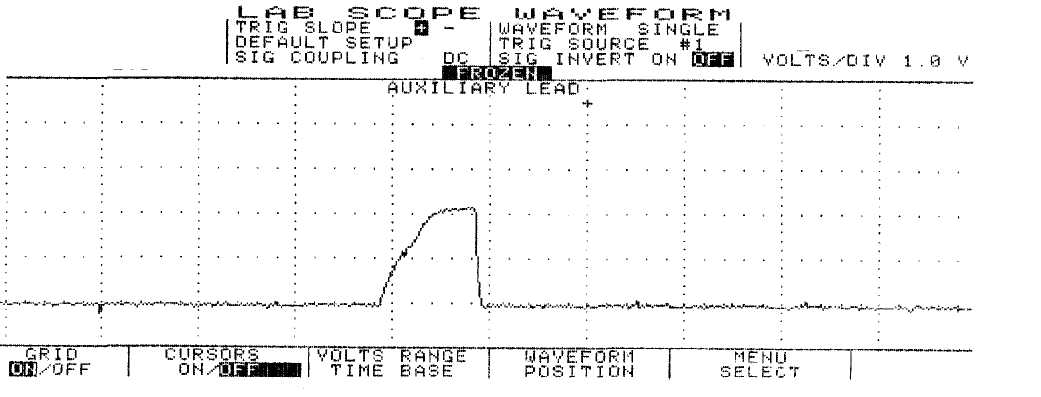
95D23864
Fig. 4: Injector Bank w/Normal Current Flow - Current Pattern
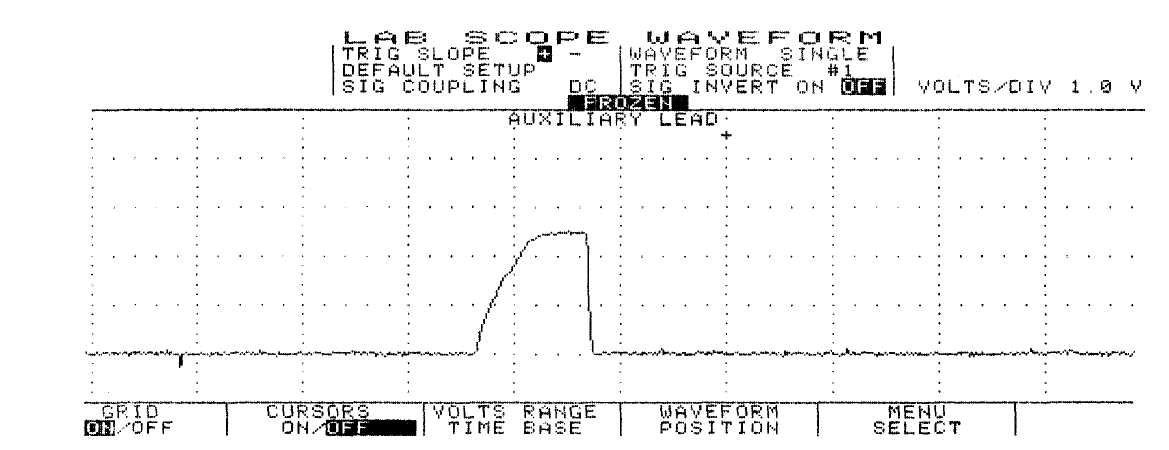
ąŁ5ąĢ23865
Fig. 5: Injector Bank w/Excessive Current Flow - Current Pattern
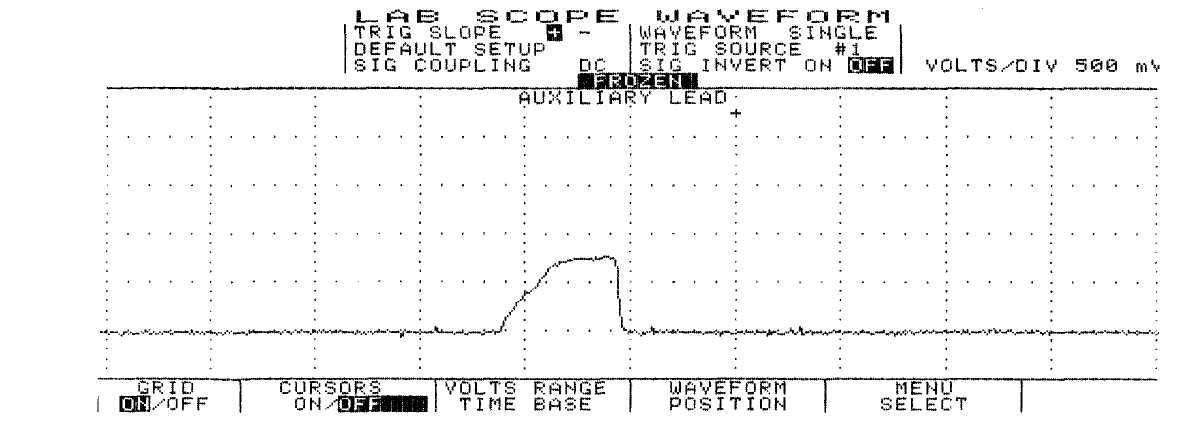
95F23866
Fig. 6: Single Injector w/Normal Current Flow - Current Pattern

Fig. 7: Single Injector w/Excessive Current Flow - Current Pattern
EXAMPLE #2 - VOLTAGE CONTROLLED DRIVER
This time we will look at a GM 3.1L V6 VIN [T]. Fig. 8 shows the 1, 3, 5 (odd) injector bank with the current waveform indicating about a 2.6 amp draw at idle. This pattern, taken from a known good vehicle, correctly stays at or below the maximum 2.6 amps current range. Ideally, the current for each bank should be very close in comparison.
Notice the small dimple on the current flowÆs rising edge. This is the actual injector opening or what engineers refer to as the "set point." For good idle quality, the set point should be uniform between the banks.
When discussing OhmÆs Law as it pertains to this parallel circuit, consider that each injector has specified resistance of 12.2 ohms. Since all three injectors are in parallel the total resistance of this parallel circuit drops to 4.1 ohms. Fourteen volts divided by four ohms would pull a maximum of 3.4 amps on this bank of injectors. However, as we discussed in EXAMPLE #1 above, other factors knock this value down to roughly the 2.6 amp neighborhood.
Now we are going to take a look at the even bank of
injectors; injectors 2, 4, and 6. See Fig. 9. Notice this bank peaked at 1.7 amps at idle as compared to the 2.6 amps peak of the odd bank ( Fig. 8). Current flow between even and odd injectors banks is not uniform, yet it is not causing a driveability problem. That is because it is still under the maximum amperage we figured out earlier. But be aware this vehicle could develop a problem if the amperage flow increases any more.
Checking the resistance of this even injector group with a DVOM yielded 6.2 ohms, while the odd injector group in the previous example read 4.1 ohms.
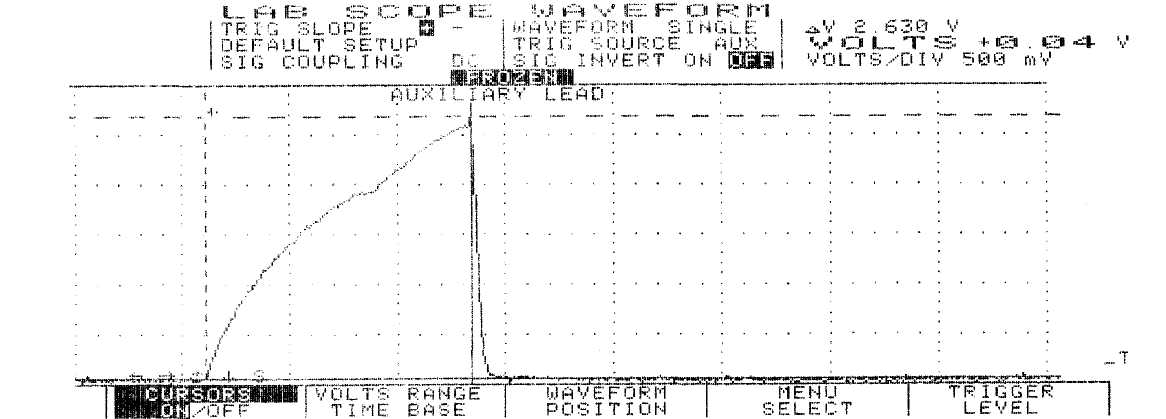
Fig.
95E23873
Injector Odd Bank w/Normal Current Flow - Current Pattern
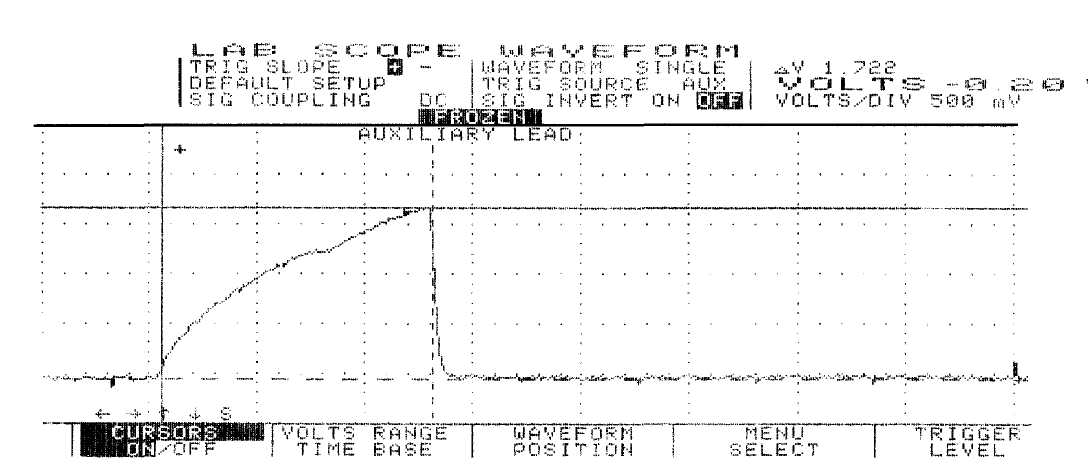
95F23874
Fig. 9: Injector Even Bank w/Normal Current Flow - Current Pattern
EXAMPLE #3 - VOLTAGE CONTROLLED DRIVER
Example #3 is of a Ford 5.0L V8 SEFI. Fig. 10 shows a waveform of an individual injector at idle with the Lab Scope set on 200 milliamps per division. Notice the dimple in the rising edge. This dimple indicates the actual opening of the injector (set point) occurred at 400 milliamps and current peaked at 750 milliamps. This is a good specification for this engine.
The next waveform pattern in Fig. 11 shows an abnormality with another injector. With the Lab Scope set on 500 milliamps per division, you can see that the current waveform indicates a 1200 milliamp draw. This is a faulty injector.
Abnormally low resistance injectors create excessive current draw, causing rough idle, and possible computer driver damage.
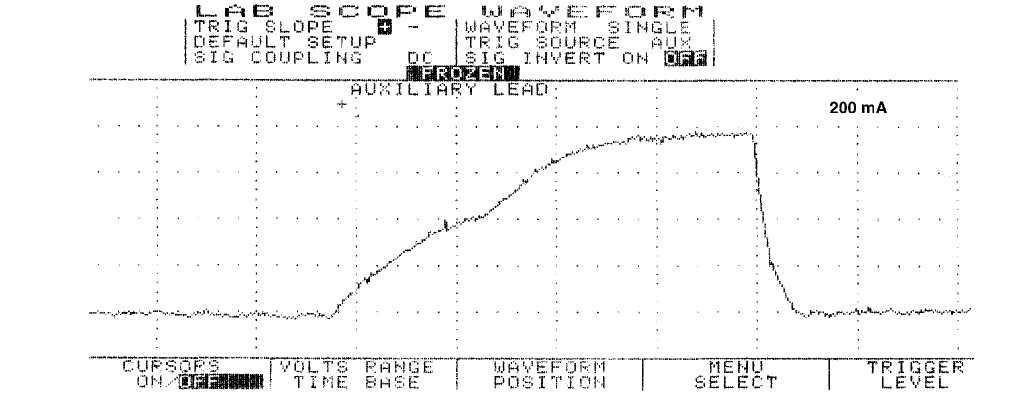
95G23875
Fig. 10: Single Injector w/Normal Current Flow - Current Pattern
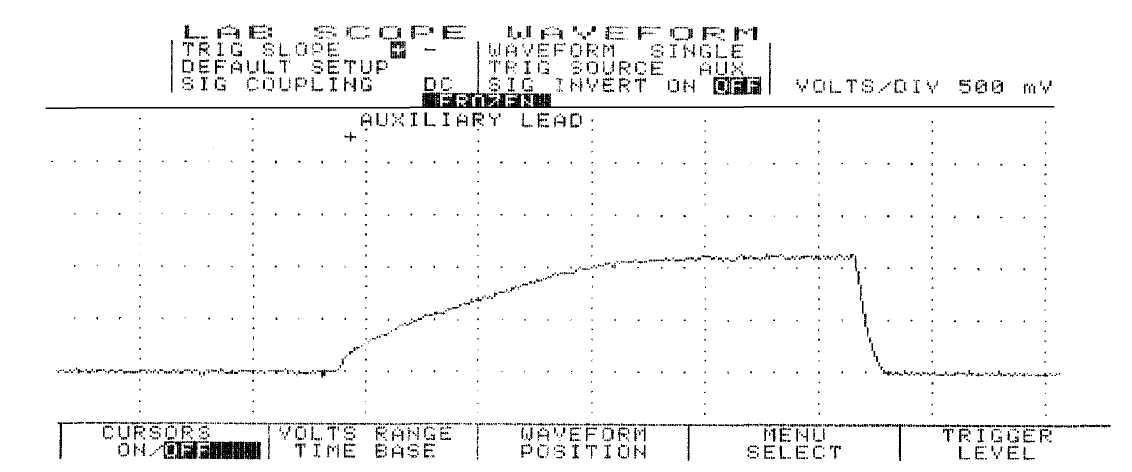
95H23876
Fig. 11: Single Injector w/Excessive Current Flow - Current Pattern
EXAMPLE #4 - CURRENT CONTROLLED DRIVER
Example #4 is of a Ford 4.6L SEFI VIN [W]. See Fig. 12 for the known-good waveform pattern. This Ford system is different from the one above in EXAMPLE #3 as it peaks at 900 milliamps and the actual opening of the injector (set point) is just below 600 milliamps.
This is offered as a comparison against the Ford pattern listed above, as they are both Ford SEFI injectors but with different operating ranges. The point is that you should not make any broad assumptions for any manufacturer.
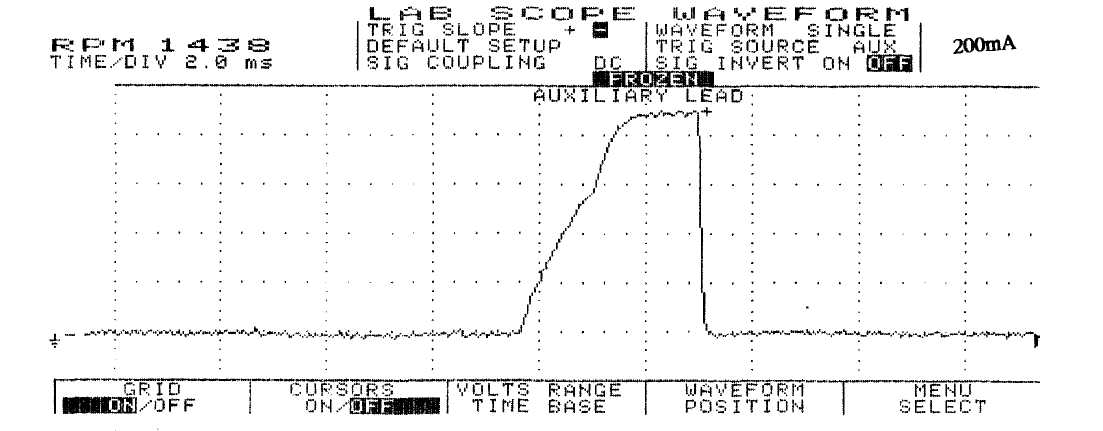
95D23872
Fig. 12: Single Injector w/Normal Current Flow - Current Pattern
EXAMPLE #5 - CURRENT CONTROLLED DRIVER
The known-good waveform in Fig. 13 is from a Chrysler 3.0L V6
PFI VIN [3]. It is a perfect example of the peak and hold theory. The waveform shows a 1-amp per division current flow, ramping to 4 amps and then decreasing to 1-amp to hold the injector open.
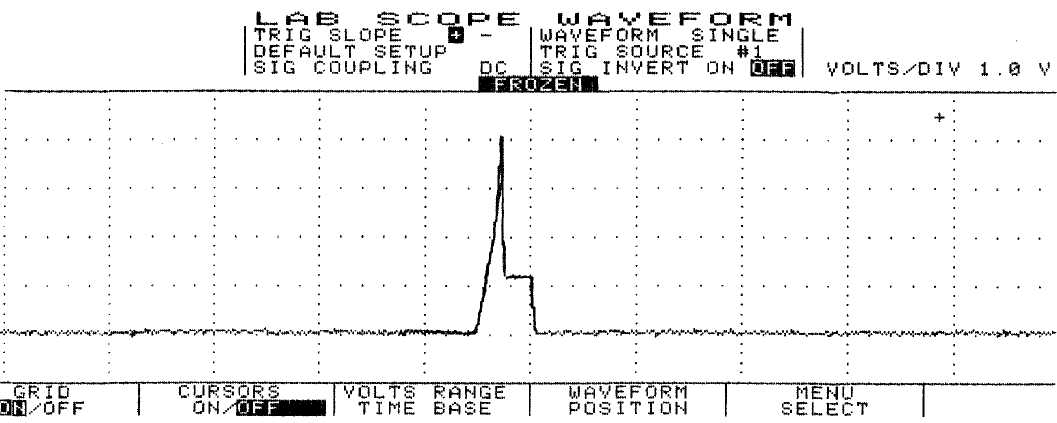
AUXILIARY LEAD
ąŁ5ąØ23868
Fig. 13: Injector Bank w/Normal Current Flow - Current Pattern
EXAMPLE #6 - CURRENT CONTROLLED DRIVER
This next known-good waveform is from a Ford 5.0L V8 CFI VIN [F]. See Fig. 14. The pattern, which is set on a 250 milliamps scale, indicates a 1.25 amp peak draw and a hold at 350 milliamps.
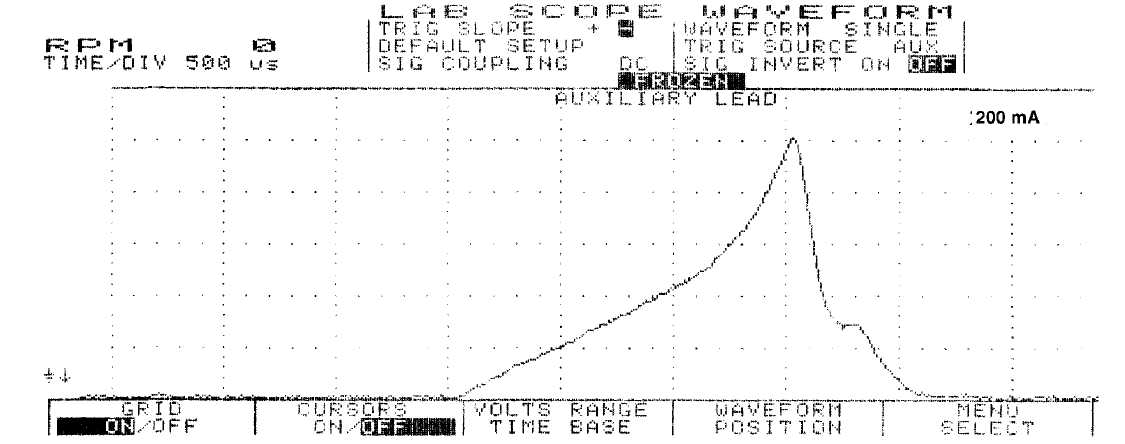
95I238S9
Fig. 14: Single Injector w/Normal Current Flow - Current Pattern
EXAMPLE #7 - CURRENT CONTROLLED DRIVER
The known-good current controlled type waveform in Fig. 15 is from a GM 2.0L TBI VIN [1]. With the lab scope set at 2 amps per division, notice that this system peaks at 4 amps and holds at 1 amp.
The next waveform is from the same type of engine, except
that it shows a faulty injector. See Fig. 16. Notice that the current went to almost 5 amps and stayed at 1 amp during the hold pattern. Excessive amounts of current flow from bad injectors are a common source of intermittent computer shutdown. Using a current waveform pattern is the most accurate method of pinpointing this problem.
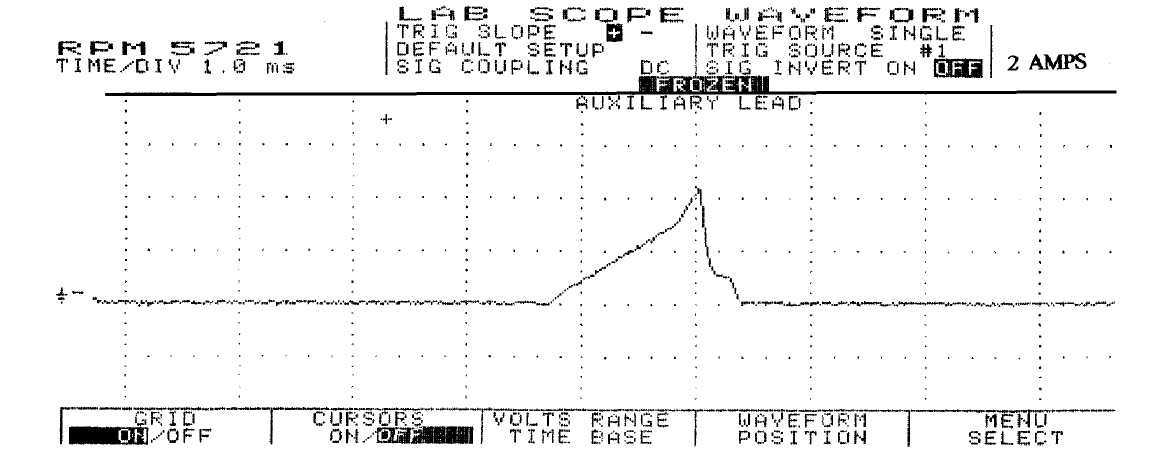
9SC23871
Fig. 15: Single Injector w/Normal Current Flow - Current Pattern
S ąĪ ą× f=> ąĢąĢ
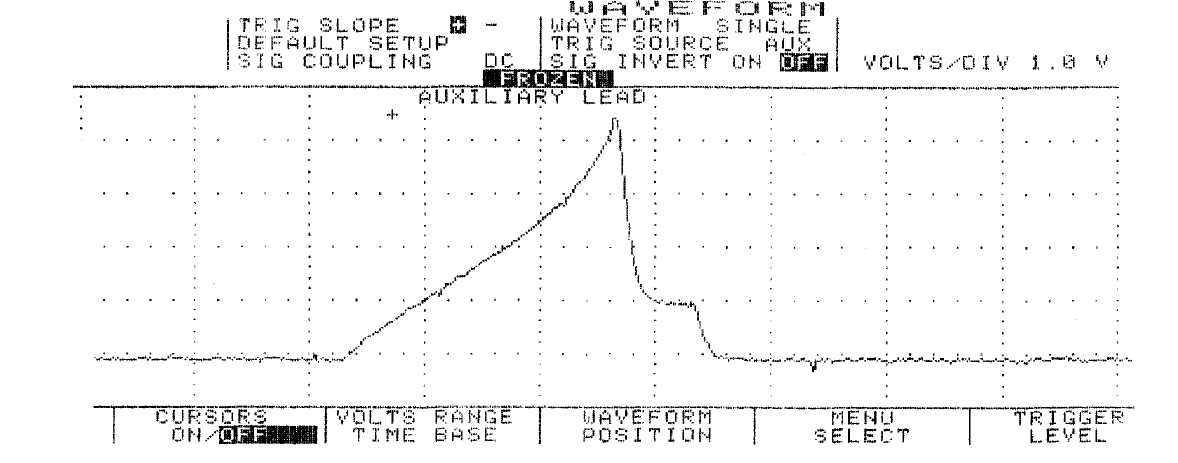 L... &, ą×
L... &, ą×
95123877
Fig. 16: Single Injector w/Excessive Current Flow - Current Pattern
EXAMPLE #8 - CURRENT CONTROLLED DRIVER
This known-good CPI system waveform from a GM 4.3L V6 CPI VIN [W] peaks at 4 amps and holds at 1-amp. See Fig. 17 for waveform.
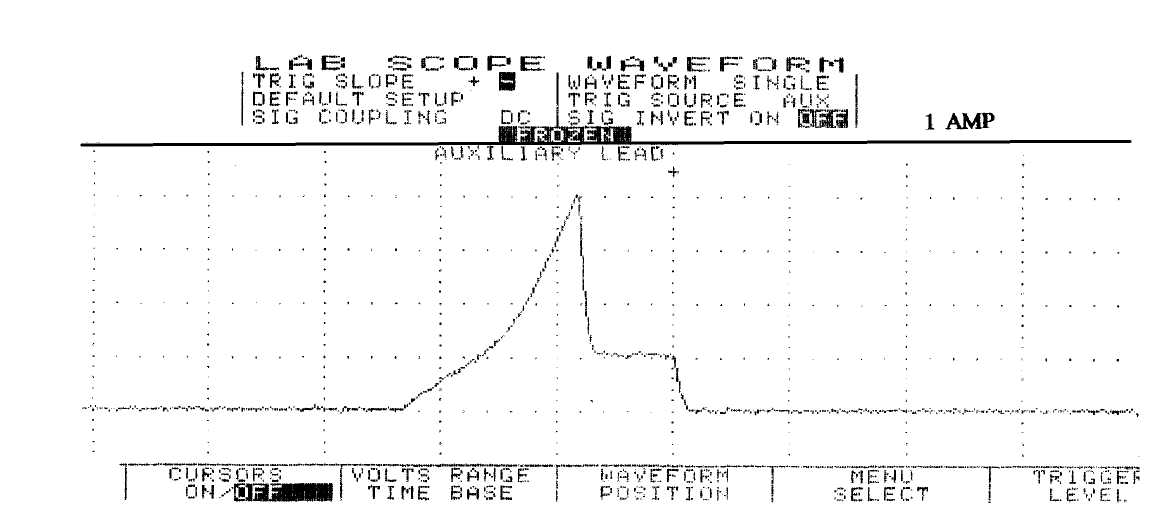
95B23870
Fig. 17: Single Injector w/Normal Current Flow - Current Pattern
VOLTAGE WAVEFORM SAMPLES
EXAMPLE #1 - VOLTAGE CONTROLLED DRIVER
These two known-good waveform patterns are from a Ford 4.6L V8 VIN [W]. Fig. 18 illustrates the 64 volt inductive kick on this engine, indicating no clamping is occurring. The second pattern, Fig. 19, was taken during hot idle, closed loop, and no load.
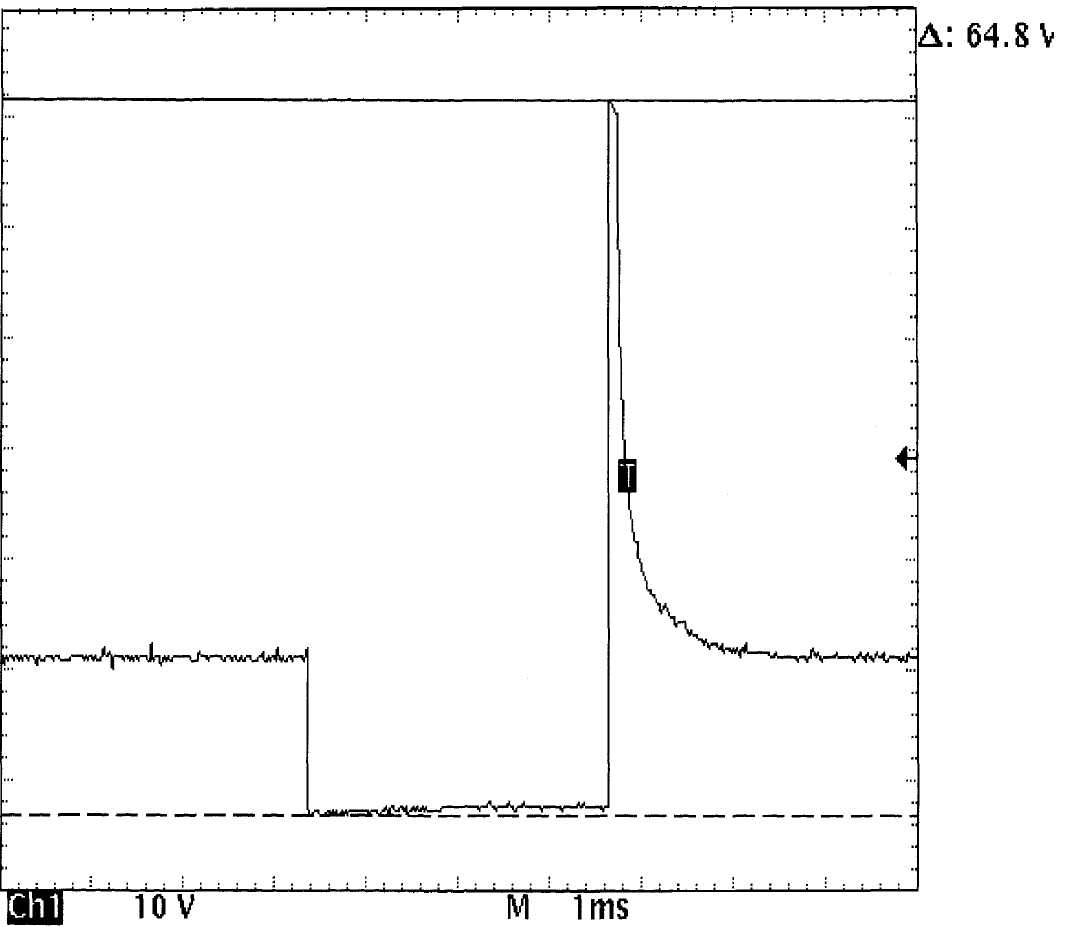
95E23857
Fig. 18: Injector Bank - Known Good - Voltage Pattern
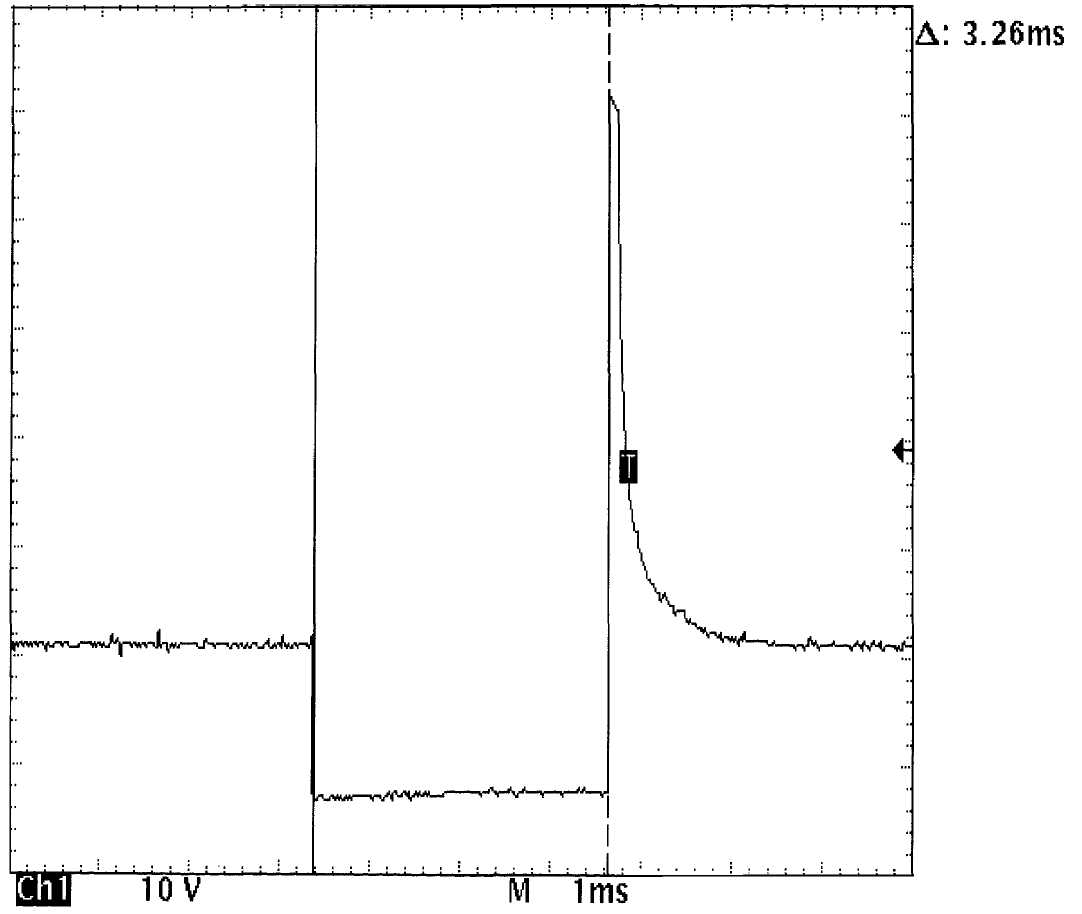
95F23858
Fig. 19: Injector Bank - Known Good - Voltage Pattern
EXAMPLE #2 - VOLTAGE CONTROLLED DRIVER
The known-good waveform pattern in Fig. 20 is from a GM 3.8L V6 PFI VIN [3]. It was taken during hot idle, closed loop and no load.
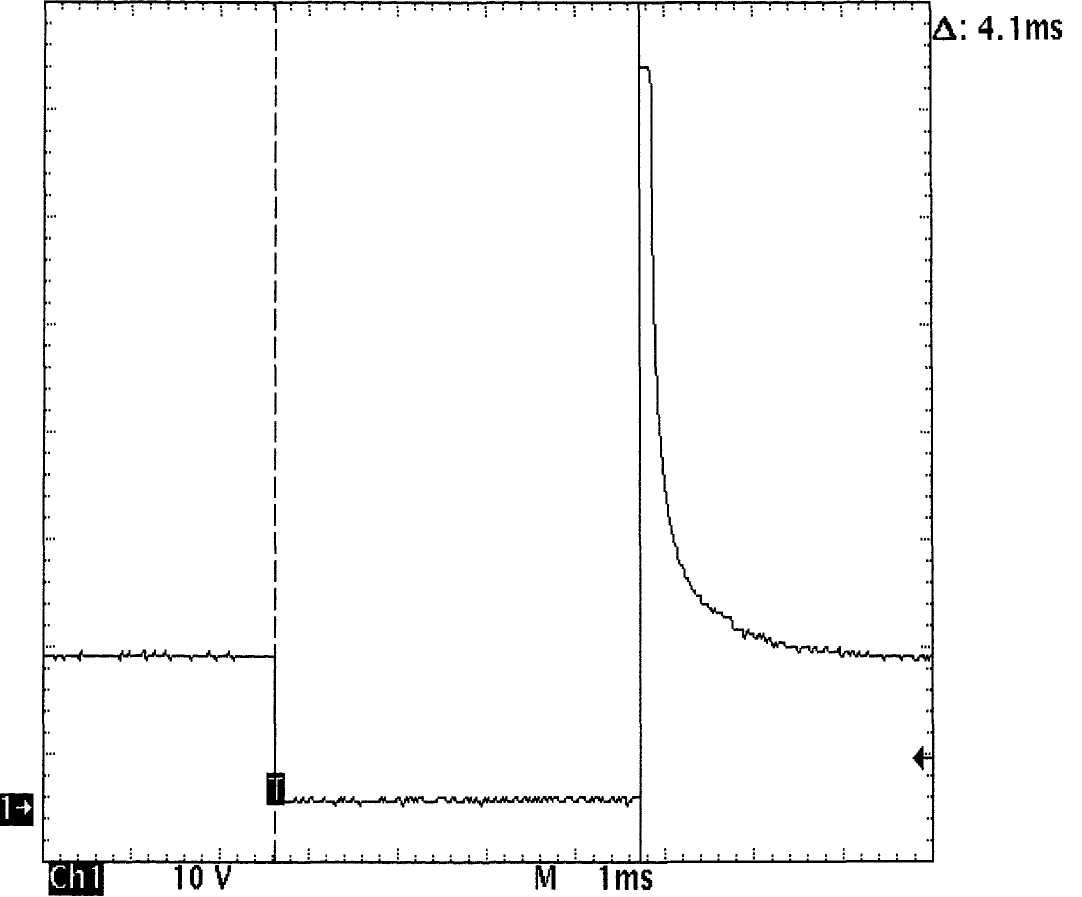
95123851
Fig. 20: Injector Bank - Known Good - Voltage Pattern
EXAMPLE #3 - VOLTAGE CONTROLLED DRIVER
This known-good waveform pattern, Fig. 21, is from a GM 5.0L V8 TPI VIN [F]. It was taken during hot idle, closed loop and no load.

95G23859
Fig. 21: Injector Bank - Known Good - Voltage Pattern
EXAMPLE #4 - CURRENT CONTROLLED DRIVER
From 1984 to 1987, Chrysler used this type injector drive on their TBI-equipped engines. See Fig. 22 for a known-good pattern. Instead of the ground side controlling the injector, Chrysler permanently grounds out the injector and switches the power feed side. Most systems do not work this way.
These injectors peak at 6 amps of current flow and hold at 1 amp.
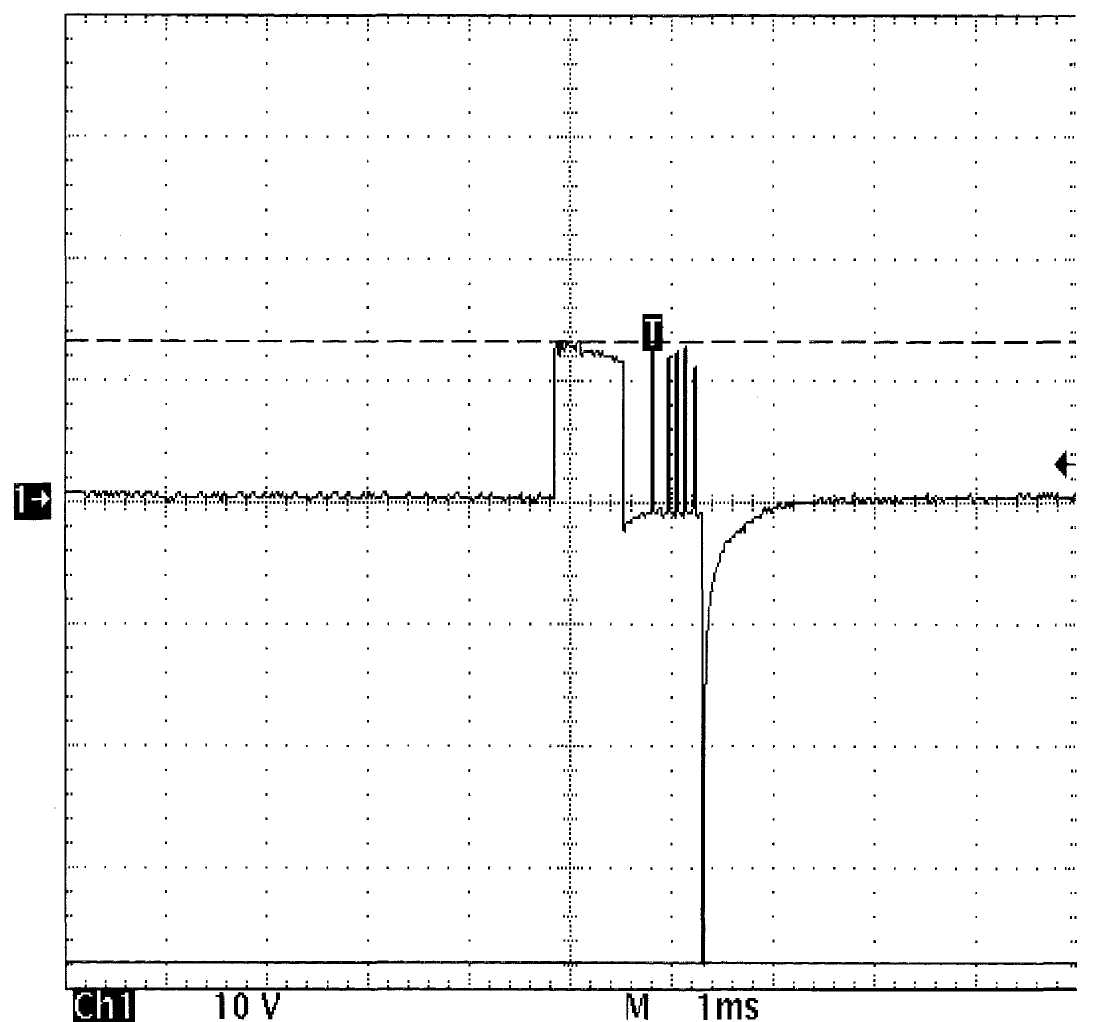
95J23860
Fig. 22: Single Injector - Known Good - Voltage Pattern
EXAMPLE #5 - CURRENT CONTROLLED DRIVER
These two known-good waveform patterns are from a Chrysler 3. 0L V6 VIN [3]. The first waveform, Fig. 23, is a dual trace pattern that illustrates how Chrysler uses the rising edge of the engine speed signal to trigger the injectors. The second waveform, Fig. 24, was taken during hot idle, closed loop, and no load.
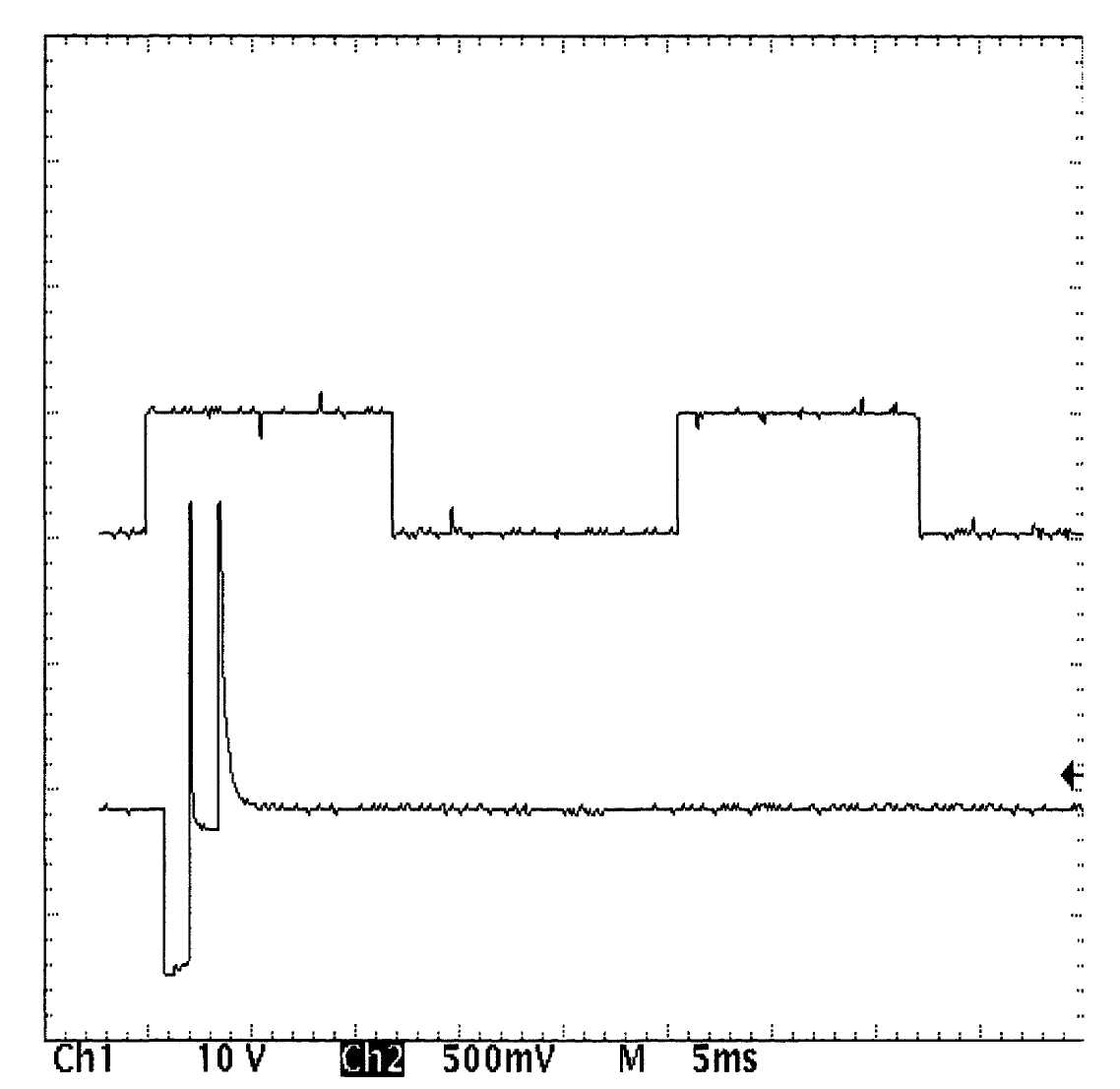
ąŁ5ąÉ23861
Fig. 23: Injector Bank - Known Good - Voltage Pattern
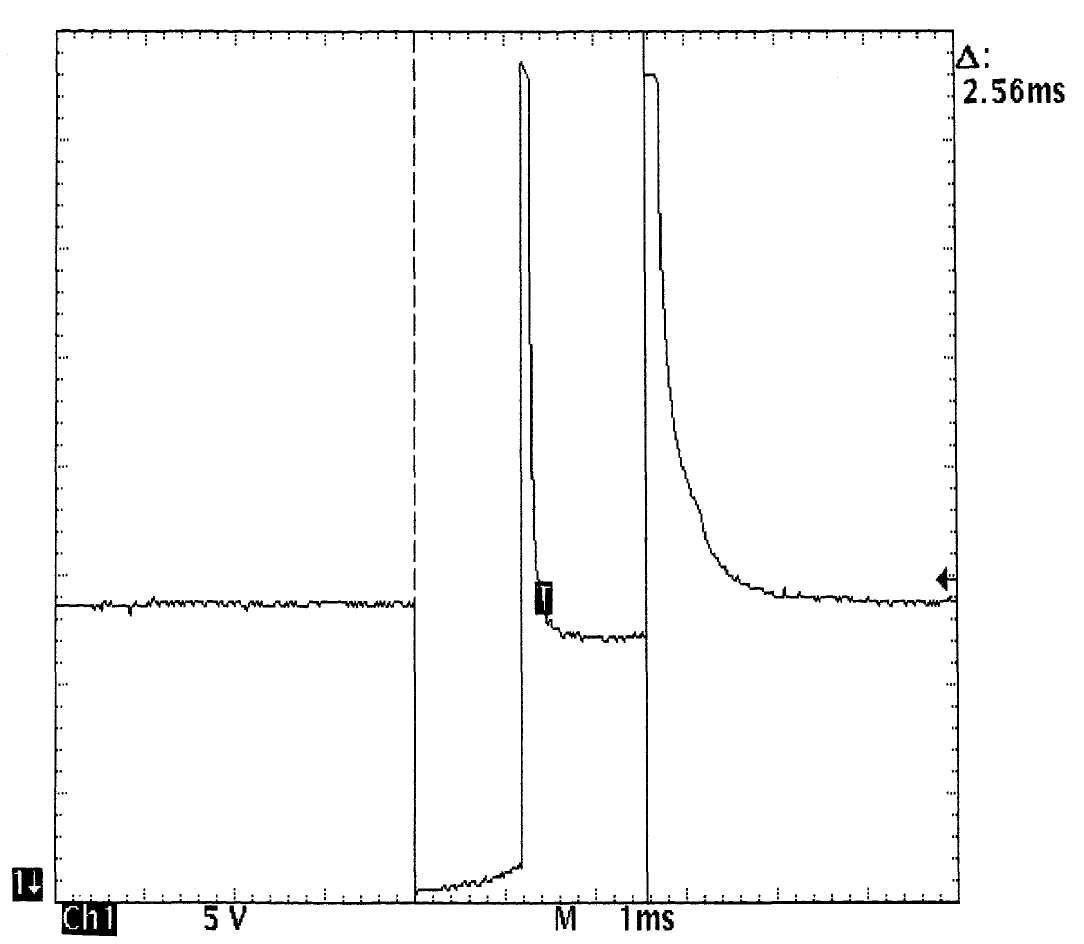
95B23854
Fig. 24: Injector Bank - Known Good - Voltage Pattern
EXAMPLE #6 - CURRENT CONTROLLED DRIVER
This known-good pattern from a Ford 3.0L V6 PFI VIN [U] illustrates that a zener diode inside the computer is used to clamp the injectorÆs inductive kick to 35-volts on this system. See Fig. 25.
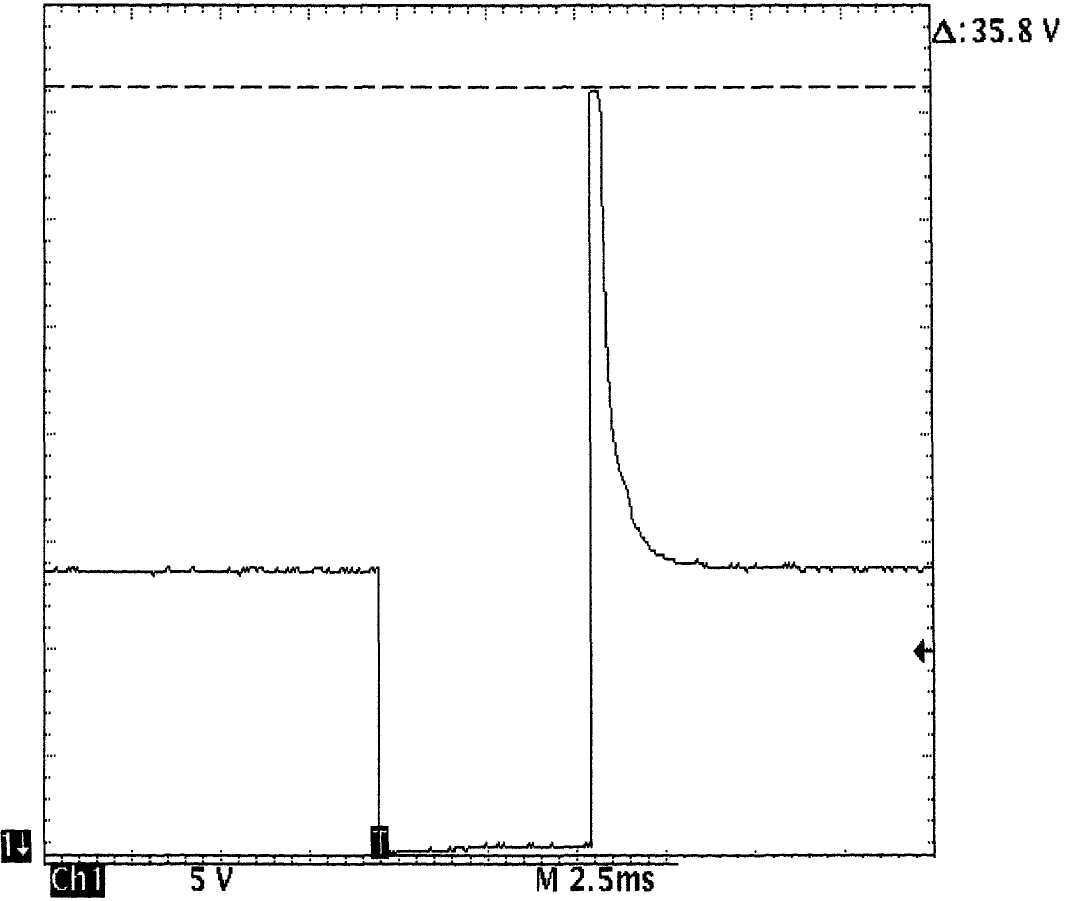
95J23852
Fig. 25: Injector Bank - Known Good - Voltage Pattern
EXAMPLE #7 - CURRENT CONTROLLED DRIVER
This known-good waveform from a Ford 5.0L V8 CFI VIN [F] was taken during hot idle, closed loop, and no load. See Fig. 26.
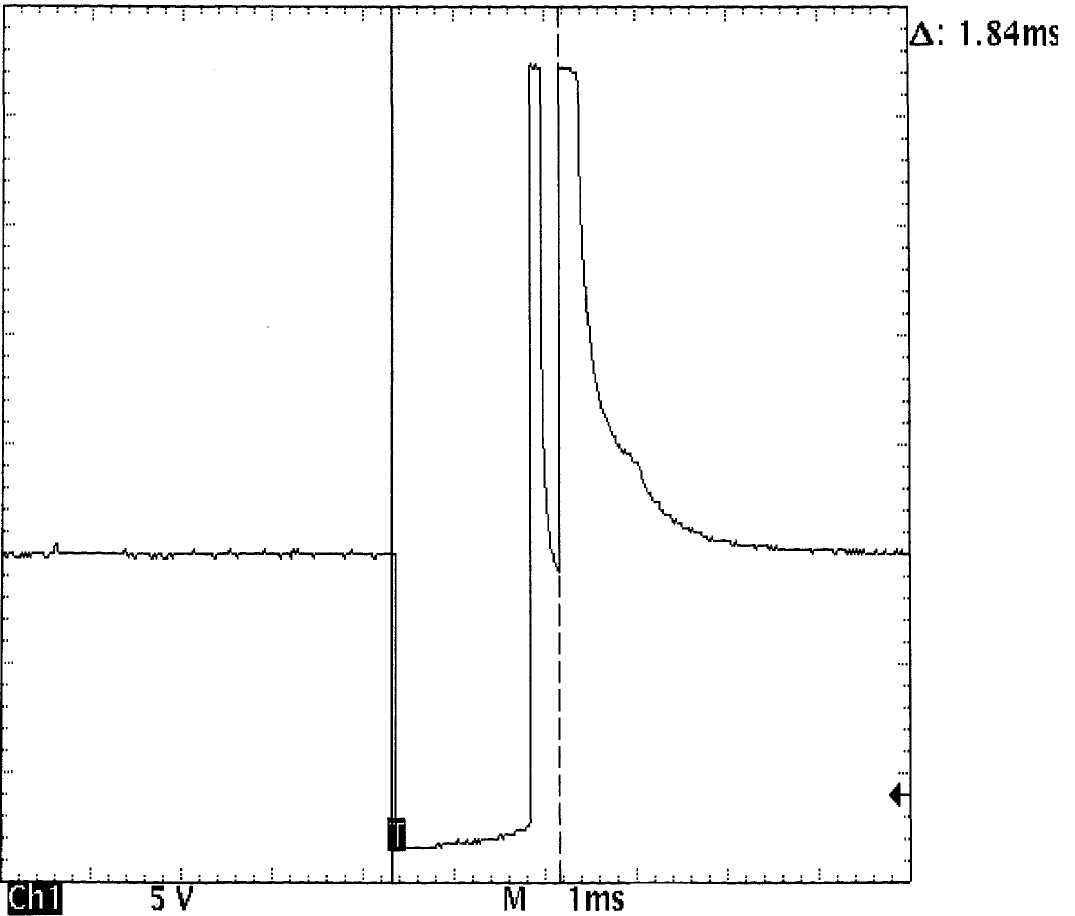
95D23856
Fig. 26: Single Injector - Known Good - Voltage Pattern
EXAMPLE #8 - CURRENT CONTROLLED DRIVER
These two known-good waveform patterns are from a GM 2.0L In-Line 4 VIN [1]. Fig. 27 illustrates the 78 volt inductive spike that indicates a zener diode is not used. The second waveform, Fig. 28, was taken during hot idle, closed loop, and no load.

95D23849
Fig. 27: Single Injector - Known Good - Voltage Pattern
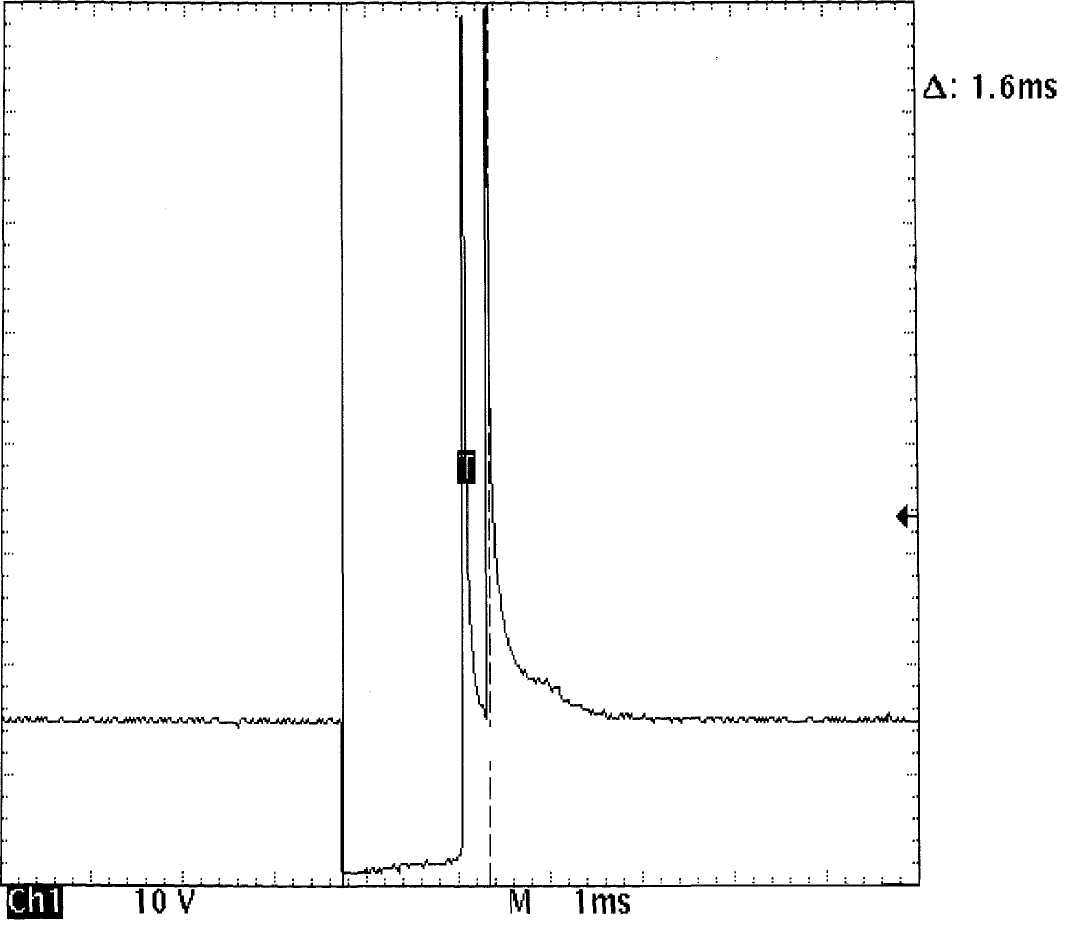
9SH23850
Fig. 28: Single Injector - Known Good - Voltage Pattern